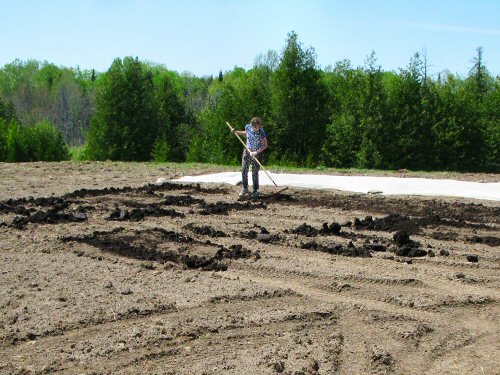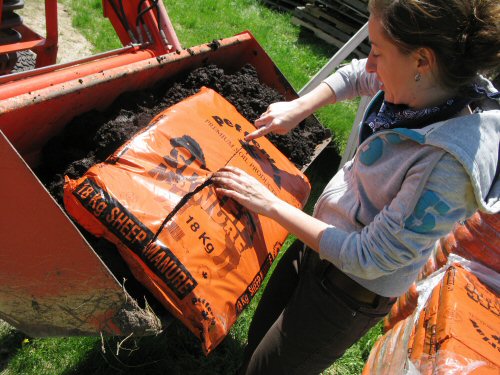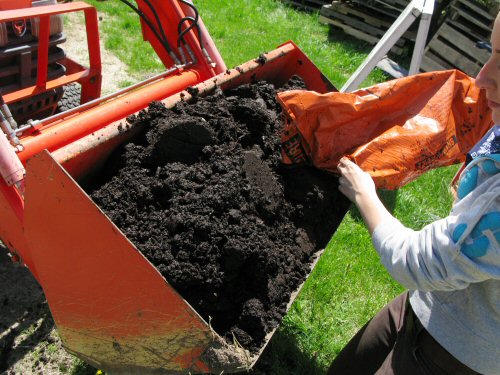
When there’s a whole small section to cover, spreading compost with the Kubota compact tractor bucket is a lot faster and more efficient than the painstaking bed-by-bed method. This has been my usual approach for spot spreading, usually for 50’x50′ squares. Covered in reverse: the roughly distributed compost is quickly raked out (looks like a lot of work, but only takes 5-10 minutes!), before being rototilled in.

The real trick is backing up while dumping, rotating the bucket up and down. As long as the compost is flowing and not too clumped, this works great, gets a lot of the job done.


After a little experimentation, we came up with a simple debagging method, Lynn demonstrates: slit the bag in the bucket, then quickly flip it, pull up, and give it a couple of shakes. This compost is quite heavy (35% moisture, the label says?! expensive certified organic water…), so it quite easily tumbles out… And there we go, tiny methods for the tiny farm!




I’ve often wondered if there was some way to get our broadcast seeder to throw around compost for us. I envision it working better with the worm castings we use than conventional compost though, given the uniform shape. As is the case many times though, there wasn’t enough time to mess around this year! Next year! Next year!
lol I hear ya David!
If “next year” ever comes, I’m in t-r-o-u-b-l-e!!
They do have small manure spreaders that a yard tractor could pull. This would probably be an easy alternative.
couldn’t you just put the bags in the bucket then drop them off on the different beds and then open the bags. no wastage as any spills would be in the bed anyway?
David: Well, I’m gonna use our walking-with-bag-over-shoulder broadcast seeder to distribute the alfalfa pellets (I mean, deer food). Then till it in (so the deer won’t come)…
Scott: Yes, they always come up! They exist, I haven’t tried one, and haven’t talked to anyone who has. They might work for what I need (short beds), but there’s likely a problem because the small ones are ground-driven. Recently discussed here.
organicheri: Next year, I’d like to work with someone who welds and fabricates and knows farm gear to “design” some sort of small spreader that’d do what we need…
jim: Yep, and we’ve tried that. You find that most repetitive tasks are most efficiently done broken down into the smallest parts, each done in shot, with as little extra movement as possible. So it’s actually more work to distribute all those dozens of bags, then cut them open one by one and empty them. Easier to do a bunch of cutting and dumping in one spot (from pallet into bucket), even if there’s an extra shoveling step. At least, that’s what we found. Discussed in more detail here (of course! :).
Mike,
First off, great blog. You officially stole my weekend as a sat reading it for 3. I help run an urban farm and we garden with a resource intensive no-till method. I often wonder the feasibility of this on a larger scale (a farm of your size).
Have you considered building beds using a no-till method and thus creating permanent beds? This would reduce your dependency on tractors and also be a lot better for the soil. We find if you have access to the resources, it can reduce the labor significantly.
Any thoughts? Thanks!